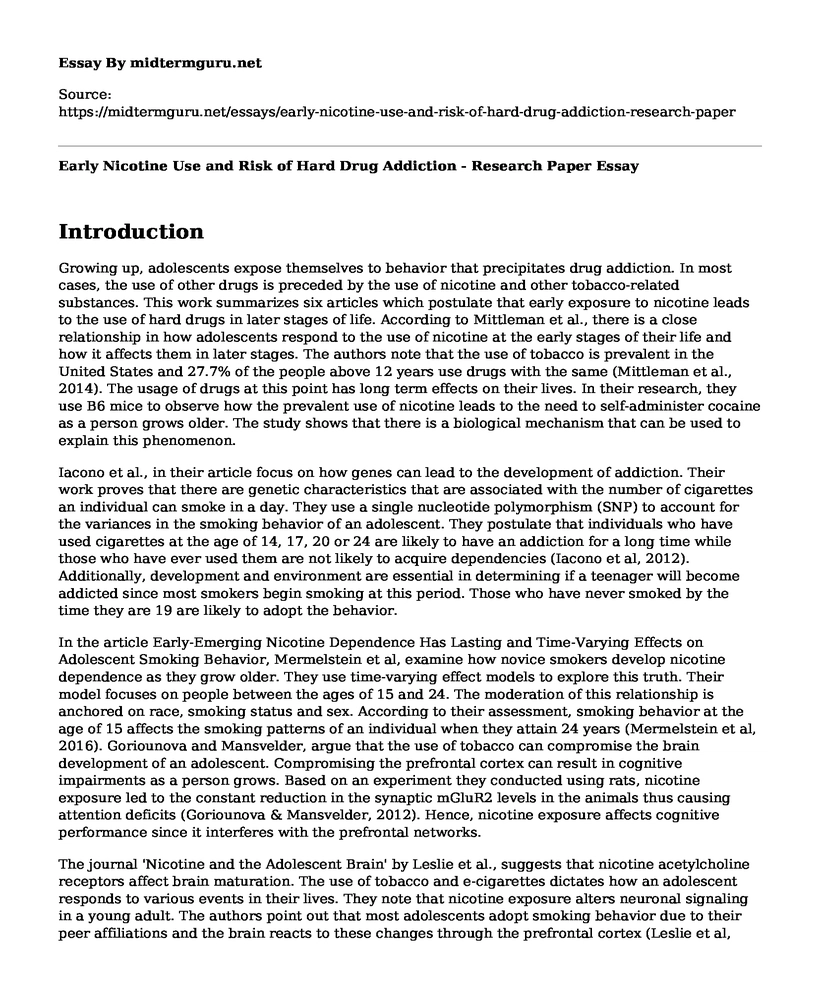Introduction
Growing up, adolescents expose themselves to behavior that precipitates drug addiction. In most cases, the use of other drugs is preceded by the use of nicotine and other tobacco-related substances. This work summarizes six articles which postulate that early exposure to nicotine leads to the use of hard drugs in later stages of life. According to Mittleman et al., there is a close relationship in how adolescents respond to the use of nicotine at the early stages of their life and how it affects them in later stages. The authors note that the use of tobacco is prevalent in the United States and 27.7% of the people above 12 years use drugs with the same (Mittleman et al., 2014). The usage of drugs at this point has long term effects on their lives. In their research, they use B6 mice to observe how the prevalent use of nicotine leads to the need to self-administer cocaine as a person grows older. The study shows that there is a biological mechanism that can be used to explain this phenomenon.
Iacono et al., in their article focus on how genes can lead to the development of addiction. Their work proves that there are genetic characteristics that are associated with the number of cigarettes an individual can smoke in a day. They use a single nucleotide polymorphism (SNP) to account for the variances in the smoking behavior of an adolescent. They postulate that individuals who have used cigarettes at the age of 14, 17, 20 or 24 are likely to have an addiction for a long time while those who have ever used them are not likely to acquire dependencies (Iacono et al, 2012). Additionally, development and environment are essential in determining if a teenager will become addicted since most smokers begin smoking at this period. Those who have never smoked by the time they are 19 are likely to adopt the behavior.
In the article Early-Emerging Nicotine Dependence Has Lasting and Time-Varying Effects on Adolescent Smoking Behavior, Mermelstein et al, examine how novice smokers develop nicotine dependence as they grow older. They use time-varying effect models to explore this truth. Their model focuses on people between the ages of 15 and 24. The moderation of this relationship is anchored on race, smoking status and sex. According to their assessment, smoking behavior at the age of 15 affects the smoking patterns of an individual when they attain 24 years (Mermelstein et al, 2016). Goriounova and Mansvelder, argue that the use of tobacco can compromise the brain development of an adolescent. Compromising the prefrontal cortex can result in cognitive impairments as a person grows. Based on an experiment they conducted using rats, nicotine exposure led to the constant reduction in the synaptic mGluR2 levels in the animals thus causing attention deficits (Goriounova & Mansvelder, 2012). Hence, nicotine exposure affects cognitive performance since it interferes with the prefrontal networks.
The journal 'Nicotine and the Adolescent Brain' by Leslie et al., suggests that nicotine acetylcholine receptors affect brain maturation. The use of tobacco and e-cigarettes dictates how an adolescent responds to various events in their lives. They note that nicotine exposure alters neuronal signaling in a young adult. The authors point out that most adolescents adopt smoking behavior due to their peer affiliations and the brain reacts to these changes through the prefrontal cortex (Leslie et al, 2015). Peterson et al., in their work, suggest that 26.5% of high school seniors are smokers and it is why smoking among adolescents needs to be addressed. Their study relies on intervention trials that seek to prevent young adults from acquiring co-morbid psychiatric disorders. They note that psychosocial factors such as the strictness of parents influence the smoking habits of an individual. Additionally, the influence of friends plays a role in shaping this behavior (Peterson et al,2012). Hence, a critical evaluation of the psychosocial and social factors helps in determining if prevention and reduction of nicotine dependence among teenagers.
References
Bricker, J. B., Liu, J., Ramey, M., & Peterson, A. V. (2012). Psychosocial factors in adolescent nicotine dependence symptoms: A sample of high school juniors who smoke daily. Substance use & misuse, 47(6), 640-648.
Dickson, P. E., Miller, M. M., Rogers, T. D., Blaha, C. D., & Mittleman, G. (2014). Effects of adolescent nicotine exposure and withdrawal on intravenous cocaine selfadministration during adulthood in male C57BL/6J mice. Addiction biology, 19(1), 37-48.
Goriounova, N. A., & Mansvelder, H. D. (2012). Nicotine exposure during adolescence leads to short-and long-term changes in spike timing-dependent plasticity in rat prefrontal cortex. Journal of Neuroscience, 32(31), 10484-10493.
Selya, A. S., Dierker, L., Rose, J. S., Hedeker, D., & Mermelstein, R. J. (2016). Early-emerging nicotine dependence has lasting and time-varying effects on adolescent smoking behavior. Prevention Science, 17(6), 743-750.
Vrieze, S. I., McGue, M., & Iacono, W. G. (2012). The interplay of genes and adolescent development in substance use disorders: leveraging findings from GWAS meta-analyses to test developmental hypotheses about nicotine consumption. Human genetics, 131(6), 791-801.
Yuan, M., Cross, S. J., Loughlin, S. E., & Leslie, F. M. (2015). Nicotine and the adolescent brain. The Journal of physiology, 593(16), 3397-3412.
Cite this page
Early Nicotine Use and Risk of Hard Drug Addiction - Research Paper. (2023, Jan 09). Retrieved from https://midtermguru.com/essays/early-nicotine-use-and-risk-of-hard-drug-addiction-research-paper
If you are the original author of this essay and no longer wish to have it published on the midtermguru.com website, please click below to request its removal:
- The Unbelievable Murders: We Have Always Lived in the Castle
- How Race and Religion Shape My Life? - Essay Sample
- The Vampire: A Reflection of Society
- Essay Sample on Uighur Terrorism in China and Human Security
- Radicalized Terrorists - Research Paper
- Glamour of Celebrity Lifestyles: A Media Construct? - Essay Sample
- Article Analysis Essay on Examine the Connection Between Post Traumatic Stress Disorder







